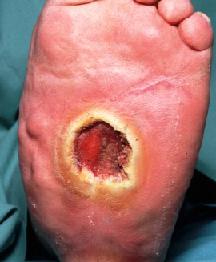- What is Peripheral arterial disease (Arteriosclerosis)
- Statistics on Peripheral arterial disease (Arteriosclerosis)
- Risk Factors for Peripheral arterial disease (Arteriosclerosis)
- Progression of Peripheral arterial disease (Arteriosclerosis)
- Symptoms of Peripheral arterial disease (Arteriosclerosis)
- Clinical Examination of Peripheral arterial disease (Arteriosclerosis)
- How is Peripheral arterial disease (Arteriosclerosis) Diagnosed?
- Prognosis of Peripheral arterial disease (Arteriosclerosis)
- How is Peripheral arterial disease (Arteriosclerosis) Treated?
- Peripheral arterial disease (Arteriosclerosis) References
What is Peripheral arterial disease (Arteriosclerosis)

Statistics on Peripheral arterial disease (Arteriosclerosis)
This is a common disorder. The incidence is approximately 1% per year for men over the age of 65 (as detected by intermittent pain in the calf/thigh).
Risk Factors for Peripheral arterial disease (Arteriosclerosis)
The main predisposing factor for the development of peripheral vascular disease is atherosclerosis.
Risk factors for atherosclerosis include:
- Smoking.
- Dyslipidaemia (abnormal concentrations of lipids or lipoproteins in the blood).
- Hypertension.
- Diabetes Mellitus.
Progression of Peripheral arterial disease (Arteriosclerosis)
Atherosclerotic and degenerative changes to the arteries of the legs lead to ischaemia of muscles and skin. This can be either chronic (usually only on exertion) or an acute episode of ischaemia (heart attack), usually related to an embolic event (a clot, usually from the heart).
Ischaemia of the muscles of the legs, particularly the calves, produces a characteristic pain on walking known as intermittent claudication, which stops on ceasing walking and recurs again when the same distance is walked. This may progress to occur at rest – classically at night, relieved by hanging the affected leg off the edge of the bed. Acute embolic disease can produce limb threatening ischaemia. Foot ulcers often develop around the malleoli and may be painful and show poor healing.
How is Peripheral arterial disease (Arteriosclerosis) Diagnosed?
Baseline checks of lipid profile, blood sugar and renal function should be done. ECG may be useful if coronary artery disease is suspected to co-exist.
Prognosis of Peripheral arterial disease (Arteriosclerosis)
The chances of losing a limb to peripheral vascular disease is quite high and hence the disease is associated with high morbidity. However most of the mortality associated with peripheral vascular disease is incidental and related to the fact that most patients have co-existing coronary artery disease and cerebrovascular disease – causing heart attacks and strokes, respectively.
How is Peripheral arterial disease (Arteriosclerosis) Treated?
Risk factors for atherosclerosis should be addressed such as smoking, lipids, diabetes and hypertension. Patients should be encouraged to exercise – since this can improve blood supply by causing additional blood vessels to open up. Foot care and trauma reduction greatly reduce the morbidity associated with peripheral vascular disease. Antiplatelet drugs should be used to prevent risk of myocardial infarction and cerebrovascular disease.
Surgery should be considered for unstable disease or in the acute setting where limb threat is high. Options include angioplasty for stenoses and removal of clots in embolic disease. Severely necrotic limbs may require amputation.
Peripheral arterial disease (Arteriosclerosis) References
- Hurst’s The Heart 8th Edition, McGRAW-HILL 1994.
- Kumar and Clark Clinical Medicine 4th Edition, W.B SAUNDERS 1998.
- MEDLINE Plus.
All content and media on the HealthEngine Blog is created and published online for informational purposes only. It is not intended to be a substitute for professional medical advice and should not be relied on as health or personal advice. Always seek the guidance of your doctor or other qualified health professional with any questions you may have regarding your health or a medical condition. Never disregard the advice of a medical professional, or delay in seeking it because of something you have read on this Website. If you think you may have a medical emergency, call your doctor, go to the nearest hospital emergency department, or call the emergency services immediately.







